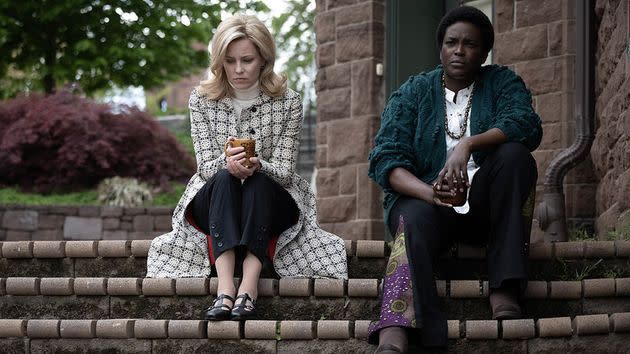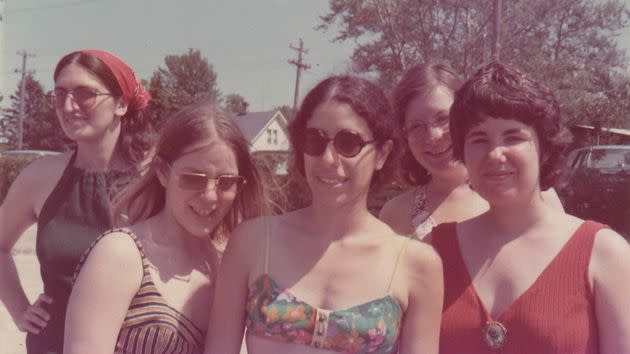3 Sundance Movies Tell Timely Stories About Abortion, But Also Miss The Mark

Abortion rights in the U.S. are at their most dire point in decades, with the conservative majority on the Supreme Court closer than ever to potentially overturning Roe v. Wade. Meanwhile, Republican-led state legislatures are trying to enact restrictive abortion laws at a fever pitch. Against this backdrop, a trio of movies that premiered this week at the Sundance Film Festival, which all take place during times when abortion was illegal, could not be more timely.
The drama “Call Jane” and the documentary “The Janes” both tell the story of the Jane Collective, an underground network of activists in Chicago who banded together to coordinate and provide secret abortions in the 1960s and early 1970s. “Happening” is a tense drama about a university student desperately trying to find a way to terminate her pregnancy in 1960s France, where abortion was also illegal at the time. While each film provides a grim reminder of what’s at stake if Roe v. Wade is dismantled, “Call Jane” and “Happening” repeat plotlines that are overrepresented in abortion-related stories on-screen and are limited in scope.
Abortion storylines in pop culture can help reduce the stigma attached to talking about them, and in recent years, more movies and TV shows have been telling abortion stories. But they tend to disproportionately center white cisgender women. Moreover, many people face financial and logistical barriers to abortion access. By contrast, movie and TV protagonists are often shown overcoming those barriers relatively easily, as researcher Steph Herold, who studies how abortion is depicted on-screen, told HuffPost in December.
“Happening” and “Call Jane” repeat both patterns. In each film, the protagonist is a white cisgender woman. While the illegality of abortion is certainly a major barrier, once each character is able to find someone who performs illegal abortions, she has the money to pay for the procedure. Directed by French filmmaker Audrey Diwan, “Happening” follows Anne (Anamaria Vartolomei), who discovers she’s pregnant after a one-night stand. An aspiring professor, she’s determined to find a way to terminate her pregnancy in order to continue her studies.

Through close-up shots and tense music, the movie is grippingly unnerving at every turn. As the weeks go by and time is running out for Anne, the stress piles up. She is wary of telling anyone about her situation because of the illegality of abortion, as well as shame and bullying from her peers at school. She starts to fall behind in her classes. She then resorts to increasingly desperate and dangerous measures to find an abortion, encountering obstacle after obstacle.
Later in the film, an acquaintance gives Anne the phone number of someone who performs clandestine abortions. As the acquaintance warns, the risks are high: “It’s the lottery there. If you’re lucky, it’s labeled a ‘miscarriage.’ If some bastard doctor writes ‘abortion,’ and you don’t die, you end up in prison,” she says. Anne also finds out the procedure is expensive. So she sells her books and jewelry on campus, ultimately managing to scrounge up the money.
“Call Jane,” the feature film directorial debut of “Carol” screenwriter Phyllis Nagy, is somewhat based on the true story of the Jane Collective, with some fictionalized elements and composite characters. Suburban housewife Joy (Elizabeth Banks) finds out her pregnancy has led to a life-threatening heart condition. So her doctor (a man) petitions his hospital to approve a “therapeutic termination,” which the hospital board (all men) vetoes.
One day, Joy spots a flyer advertising safe abortions that instructs her to “call Jane,” leading to her to the anonymous collective, founded by Virginia (Sigourney Weaver). Joy gets an abortion, which costs $600. She can afford it because her husband is a high-powered attorney (though given the lack of financial autonomy for women at the time, she has to secretly withdraw it from his bank account). After the procedure, Virginia recruits her to join the collective. Joy becomes a dedicated member, driving abortion patients to and from the collective’s secret location and keeping them company during the procedure.

But by focusing on an individual narrative, the movie doesn’t go far enough in critiquing the systems that perpetuate inequities in abortion access, such as race and class barriers. There are only a handful of scenes that address these structural issues. In one of them, Gwen (Wunmi Mosaku), the only Black member of the collective, points out the homogeneity of both the leaders in the room and the people they are serving. She calls out Virginia for not being racially inclusive and making the abortions prohibitively expensive. In response, Virginia begins offering a few pro bono appointments each week.
However, this raises more problems. In a subsequent scene, the women of the collective, who are inundated with calls from people seeking abortions, debate who to prioritize for those few slots. They lament they have to turn away so many people, the only time the movie begins to confront the systemic problems at the root of abortion access.

An HBO documentary, “The Janes” addresses some of these structural issues more directly. In the film’s interviews with the real-life members, several of them discuss the group’s shortcomings when it came to race and class issues. Documentaries tend to be better equipped to put an individual story into its political and social context. But that doesn’t mean fictional narratives can’t also do that. Audiences should have multiple entry points into an issue.
On their own, “Happening” and “Call Jane” are well-crafted dramas that tell compelling and worthy stories. But when considering them in the wider context — the landscape of existing abortion stories in pop culture and where they fall short — they make clear there are many more types of stories with more types of protagonists that still need to be told.
This article originally appeared on HuffPost and has been updated.





